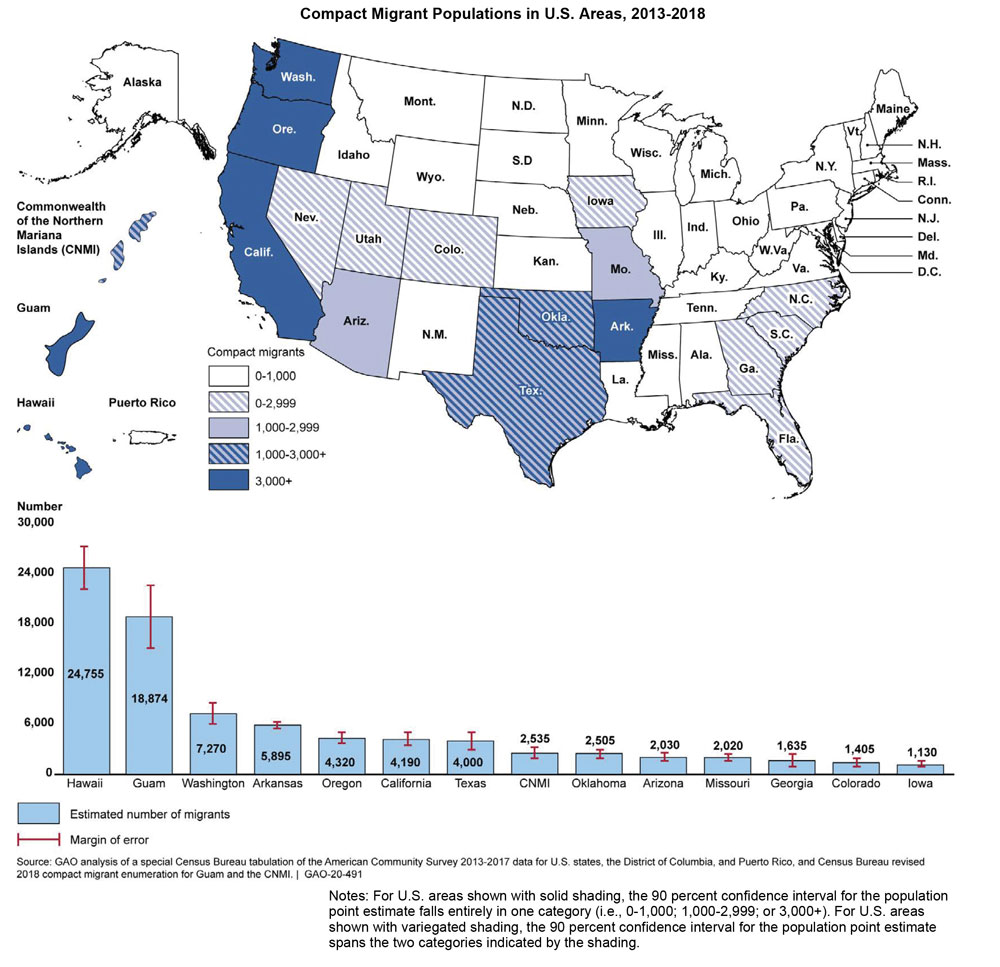FROM 56K TO OVER 90K
GAO: Compact migrants grew
Over 94,000 migrants from three countries with a Compact agreement with the United States live and work in the U.S. and its territories, according to a new study. Historically, many live in Hawaii, Guam, and the CNMI, but from 2013 to 2018, half lived in the U.S. mainland.
In the study done by the U.S. Government Accountability Office, and based on Census Bureau data covering 2005 to 2009, 2013 to 2017, and 2018, Compact migrants in the United States grew by an estimated 68%, from about 56,345 to about 94,399.
The Compact migrant population in the CNMI is 2,535, based on the GAO analysis of the Census Bureau data.
Compact migrants are citizens of the Federated States of Micronesia (Yap, Chuuk, Pohnpei, and Kosrae), Republic of the Marshall Islands, and Republic of Palau, as well as their U.S.-born children and grandchildren younger than 18 years. The U.S. Compacts of Free Association allows eligible citizens to migrate to the United States and its territories without visa and labor certification requirements. According to the GAO study, Compact migrants move to U.S. areas for a range of reasons, including greater economic and educational opportunities, better access to health care, a desire to join family members in the United States, and a wish for greater personal freedom.
As of November 2019, Compact migrants who are not U.S. citizens are eligible for select federal programs, on conditions, including Old Age, Survivors, and Disability Insurance, Emergency Medicaid, Medicare, Housing and Urban Development rental assistance, National School Lunch Program/School Breakfast Program, and Enrollment in, and financial assistance through, Patient Protection and Affordable Care Act exchanges.
Prompted by states and territories about the added cost of hosting Compact migrants, Congress authorized in 2004 and appropriated $30 million annually for 20 years, to help defray costs associated with Compact migration. While the funding ends in 2023, Compact migration is still allowed and is expected to grow.
The CNMI, with Hawaii and Guam, reported an estimated total cost of $3.2 billion, from 2004 to 2018 associated with Compact migration. Approximately $509 million in federal grants, from 2004 to 2019 was received by the three, to help defray costs of providing services to Compact migrants. Of this, the CNMI reported $116 million in total estimated Compact impact costs, and a grant funding of $53.9 million.
“The CNMI’s reported annual costs amounted to $10 million in both fiscal years 2004 and…2018, but fluctuated over time, ranging from a low of about $3 million in fiscal year 2011 to a high of $12 million in fiscal year 2014,” the report stated.
The three jurisdictions also reported Compact impact costs for education, health, public safety and social services. GAO released the fiscal year 2017 figures where $338.4 million was collectively spent, $191.2 million of which went to educational services.
Cost for the CNMI in 2017 was $775,832 for education, $2,818,223 for health, $3,487,420 for public safety, and $194,061 for social services, totaling $7,275,536.
Compact migrants, being eligible to work in the U.S., participate in the local economy in a variety of fields. In the CNMI, this is mostly grounds-keeping and maintenance and in restaurants and hotels.
Despite their contribution to the workforce, Compact migrants face a number of workforce challenges, including difficulties in obtaining commercial and/or REAL ID-compliant driver’s licenses, and labor abuse and discrimination.
CNMI officials surveyed for the study, however, describes Compact migrants as a valuable resource in supplementing the CNMI’s small labor pool.
“Seventy-nine officials also noted that, without Compact migrants, businesses would have to recruit more foreign labor and face more-severe hiring challenges than they do now. Officials and a private sector representative stated that several businesses and franchises were founded by, and employ, Compact migrants,” the GAO report said.
In addition to participating in the workforce, Compact migrants are also involved in social institutions, which help create diversity and cultural exchange in their receiving communities in the U.S., which include the CNMI.
Access the full report at https://www.gao.gov/assets/710/707555.pdf.
























